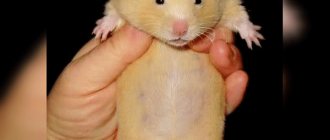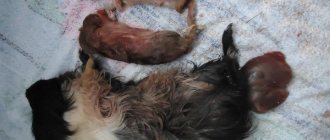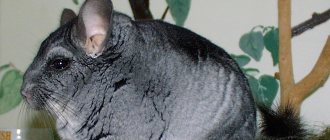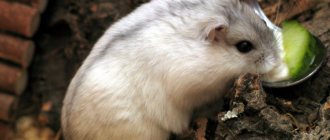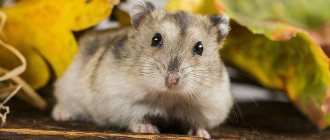Puberty
Djungarian hamsters become sexually mature at the age of 1 month. The female begins her first heat and can already become pregnant. But this does not mean that you can start breeding. It is recommended to wait until the female finally matures - her body will become stronger and maternal instinct will appear.
The ideal age of a female for the first mating is from 3 to 6 months. But you can’t wait too long - the older the female, the less chance of getting healthy offspring and giving birth without complications.
If a female becomes pregnant immediately after puberty, there is a chance that she will subsequently eat the offspring due to undeveloped maternal instincts.
Many owners often keep different-sex dwarf dogs together all the time. But in this case, you should prepare for the constant appearance of offspring. In addition, hamsters of this breed do not really like their neighbors and often fight for territory.
What to feed a baby hamster
Newborns
If the cubs are left without a mother, or the female does not have milk, the owner can feed them. The task is not easy: small hamsters need to be fed every 1.5 hours. Use soy-based infant formula 0+, dissolving and heating according to instructions. Sometimes they take Royal Canin cat milk replacer.
Each baby is fed individually from a pipette or insulin syringe without a needle. To prevent the animal from choking, it is held in a column, and milk is poured in small portions. It is advisable to massage the tummy after each feeding, monitor the presence of stool, and keep it warm.
Most hamsters die if their mother does not feed them, even when the breeder makes every effort to preserve the offspring. The reasons are different - aspiration pneumonia when milk gets into the respiratory tract, infections (the mixture does not contain maternal antibodies and does not provide strong immunity).
Hamster feeding
Babies have a greater chance of survival if they manage to find an adoptive mother - a female who has recently given birth and has a small litter. The babies are rolled around in the hamster’s toilet corner, then mixed with the “native” hamsters.
Age 1-3 weeks
When artificially feeding offspring, the sooner the hamsters start eating themselves, the better. After just a few days, the milk mixture is mixed with ground grain feed and vegetable purees are given.
Vegetable puree for babies
At 1.5 weeks of age, small hamsters can eat solid food and their chances of survival increase dramatically. Sprouted wheat, oats, a boiled egg, grated carrots and other vegetables are placed in the feeder every day. From 2 weeks of age, small hamsters need to be fed every 4 hours (6 times a day). The mixture and ground food are mixed until a paste of creamy consistency is obtained.
For both dwarf and Syrian hamsters, when feeding young animals, you need to focus on the list of permitted products. If the babies are raised by their mother, she carries her food into the nest, so they learn what the adults eat.
From 3 weeks, the cubs are no longer fed from a syringe, but the mixture is poured into a bowl.
Pairing
Djungarians need to be mated during the period when the female begins estrus. In other words, when she starts to "walk". This condition lasts from several hours to a day, and occurs approximately once a week. It is not difficult to notice - the female will begin to arch her back and raise her tail, while releasing a strong-smelling substance to attract the male. It is during this period that a male is placed with the hamster.
It is advisable to bring the male and female together in the evening, since at this time they are more active. You can’t leave Dzungarians alone right away. First you need to observe their behavior. If the female is not aggressive and shows favor towards the partner, they are left alone.
Sexual intercourse among Djungarians lasts about 1 minute. Until the female stops estrus, it is not advisable to seat the couple. To achieve a result, several acts must occur.
At the end of the mating season, the male must be placed in another cage. If you leave them together, then after the birth of the babies the male can destroy the offspring by fighting for territory. Or the female will destroy them, thus protecting them from the male.
How to keep a couple before mating: together or in different cages
Hamsters of this species reproduce well, and in captivity they are able to do this throughout the year. However, for this process they need to create certain conditions. So, before mating, it is better to keep the female and male in different cages, since they can show aggression towards each other - they will fight for territory. They need to be combined in one cage only for the duration of mating.
Note that peaceful coexistence of a boy and a girl in the same room is possible, but this is quite rare. If you do not have the opportunity to buy another cage, then you can place the female with the male for a while. Who knows, what if your couple will be on the list of those rare ones who live in peace and harmony. If the experiment fails, then it will still be necessary to decide to purchase a new cell. It is unlikely that you will like to put up with scratches and scraps of torn fur.
Read on for tips on choosing a cage and ball for your hamster.
You can avoid conflicts if you buy a girl and a boy at the same time and at the same time place them in a new cage. In this case, one male can even get along with several females. You should avoid placing a younger female with a male who has already been living with you for some time. In this case, war cannot be avoided.
Did you know? Experienced breeders have noticed that in a territorial war between males and females, the latter almost always win, and the males are inferior to them.
How to understand that a female is pregnant
Experienced hamster owners who have been breeding them for a long time know that fertilization of the female does not always occur the first time. Therefore, sometimes it is necessary to mate dzhungarikas several times.
Signs indicating a female is pregnant:
- Decreased activity.
- Increased appetite.
- Arrangement of the nest.
- Weight gain.
Usually for the first 7-10 days the hamster behaves as usual, and it is quite difficult to understand that she is pregnant. The main indicator is the absence of estrus. If the female does not start walking again a week after mating, she is most likely pregnant.
Sometimes a so-called “false pregnancy” occurs, when the behavior of a dzhungarik indicates pregnancy, but childbirth never occurs. In this case, the embryos can simply dissolve. This happens from stress. But in any case, if there is a false pregnancy, it is better to show your pet to a veterinarian.
Caring for the safety of babies
To prevent your pet from eating the babies, try to clean the cage in advance of the birth. After the babies are born, access to the hamster’s home should be limited as much as possible. Do not pick him up for communication, do not try to touch or stroke the offspring. All that is required of the owner is to carefully clean the toilet area and put food in the cage. Place the hamster's house in a quiet and calm place, eliminating the occurrence of anxiety. Several rules will help protect the cubs from the aggressive behavior of the female:
- try to minimize stressful situations;
- do not add other hamsters to the cage;
- provide the rodent with adequate nutrition;
- allow females to give birth between 4 and 12 months of age;
By providing the pet with favorable conditions during gestation and the feeding period, the likelihood of eating its own young can be reduced to zero.
Caring for a pregnant female
All necessary conditions are created for a pregnant hamster. This applies to both content and diet.
Content
The dwarf and future offspring need more space, so they select a spacious cage. The air temperature in the room should be within +21-25°C. Care should be taken to ensure that the cage is not exposed to direct sunlight. Ladders, pipes, wheels and other toys are also removed so that the expectant mother does not inadvertently injure herself.
During pregnancy, the Djungarian hamster should be protected from stress:
- You should not pay too much attention to the female, so as not to disturb her again. Otherwise, she may regard this as a threat to the cubs and simply destroy them after birth;
- It is not recommended to touch a pregnant female so as not to leave her scent.
Feeding
During pregnancy, the Djungarian hamster must receive enhanced nutrition. However, you should not include unusual foods in your diet due to the risk of an allergic reaction or diarrhea. In order for the fruits to develop properly, you will need a lot of protein:
- nuts, seeds;
- dairy products;
- eggs;
- chicken meat.
The female is also fed vegetables, fruits, and sprouted herbs. During pregnancy, a hamster especially needs calcium. The deficiency is compensated with the help of tablets or crushed chalk.
How long does pregnancy last and number of babies?
The shortest duration of pregnancy in female Syrian hamsters is 16 days. The number of cubs varies between 6-12, maybe less. Rarely occurs anymore. The maximum gestation period for Syrian hamsters is 20 days.
In dwarf hamsters, pregnancy will last 3 weeks. To be even more precise, a maximum of 22 days, taking into account the day of conception. One litter can have 4-7 cubs. Rarely does the number reach 9. In hamsters, there is a relationship between the number of fetuses and the length of pregnancy: the more cubs, the shorter the gestation period.
Preparing for childbirth
As for preparing for childbirth, the female begins to build a nest on her own. You can help her by putting soft paper, cloth or hay in her cage. Djungarik immediately uses them to build a nest for the babies.
It is forbidden to use newspapers or magazines containing printing ink - it is very harmful to children.
A few days before birth, the cage is cleaned. In this case, the house with the nest cannot be touched. It is enough to replace the filler, remove leftover food, and wash the feeder and drinking bowl. The cage can be moved to a quieter place where the female will not be disturbed by pets or household members.
Conditions of detention
Proper maintenance will affect the future health of the animals.
Improvement of the cell
When arranging the cage, consider the following aspects:
- Litter. Avoid using patches made of artificial fabric or cotton wool. Newborns may suffocate if exposed to such materials.
- Special security. Make sure that babies cannot get out of the cage on their own. If this does happen, do not pick them up to return them to the house. Better use a spoon.
- Avoid tiers. Select cages with a small distance between the bars so that the baby cannot fall out.
- Drinking bowl. If there is water in an open container, the hamsters may drown. It is better to install a container with a spout through which the animals can independently extract liquid when they grow up a little.
- Calm. The house should be located in a place away from sources of direct bright light. It is better to put the cage in a room inaccessible to children so that noise and constant attention do not disturb the female.
The birth of the Djungarians
It is not difficult to make sure that a Djungarian hamster is about to give birth. The closer this moment is, the more passive the pregnant female becomes. She even stops eating, but drinks a lot of water. Therefore, it is important to ensure that there is always clean, fresh water in the cage.
When the time comes, it is advisable that there is no one in the room with the cage. It is not recommended to interfere with the natural process of giving birth to babies, especially if you lack experience.
On average, a Djungarian hamster gives birth to about 10 babies at once (the maximum number is 18 babies, and the minimum is 2-3). Childbirth lasts several hours. Moreover, each cub appears at intervals of 10-15 minutes.
Under no circumstances should you pick up a newborn baby; the foreign smell will make the female refuse them, or worse, she will eat them.
Half an hour after giving birth, the female feeds the babies milk and falls asleep. She needs to be provided with complete rest and protected from stress for 3-4 weeks. This is exactly what is required for the cubs to grow up and become independent.
How does childbirth proceed?
The end of pregnancy is indicated by increased thirst and decreased appetite. Some hamsters become more restless towards the end of their period. Labor usually begins at night. In primiparous females they last about an hour, in experienced ones - 20-30 minutes. Small hamsters are born at intervals of 5-6 minutes.
When contractions begin, the hamster takes a characteristic position: sitting on its butt. In this position it is convenient for her to help the birth of puppies. He literally pulls them out of the birth canal with his teeth. Each newborn dzhungarik is located inside the amniotic sac. Mom breaks the shell, gnaws the umbilical cord and licks the babies.
At the end of the birth, the Djungarian hamster eats the placenta. It contains many useful substances. The female then feeds her young with milk first. If there are stillborn or very weak babies in the litter, the female eats them. Thus, it satisfies the nutritional needs that enable it to feed healthy children.
If your hamster was pregnant for the first time, he may become confused during labor. In this case, you need to help her. The Zungarik, which has emerged from the birth canal, is freed from the amniotic sac with a napkin - it should not be touched with hands. Mucus from the nose and mouth is removed with a small syringe. The hamster is then handed over to its mother. He has to accept it and lick it.
this is interesting. Djungarians are born bald, blind and deaf. Their weight does not exceed 2 g. They look like worms that can only move their legs and open their mouths. The skin of newborn hamsters is pink, through which blood vessels and internal organs are visible.
Possible problems and complications
Djungarian hamsters often have health problems during pregnancy and childbirth:
- Toxicosis . It is extremely rare among Djungarians, but unlike people, it is dangerous for a pregnant female. In this case, toxicosis develops during childbirth and even after it. There is no treatment, so it is deadly for the mother (and often for the offspring).
- Pathologies of childbirth . Before mating hamsters, be sure to pay attention to their age. This is especially true for females older than one year. By this age, their pelvic organs lose elasticity, which makes it more difficult for them to give birth. If there are few cubs (2−3), then they are larger than usual. In such a situation, the only way to save the hamster and its offspring is through surgery.
- Fetal death . This is caused by an infection or genetic disease. To save the dwarf, you also cannot do without surgery.
- Endometritis . The first symptoms of the disease are bloody discharge with an unpleasant odor that does not stop for several days. This sign often indicates the presence of a dead fetus inside.
- Mastitis . Females feed their babies on their own, and often no problems arise. But if during lactation signs such as fever, redness and enlargement of the mammary glands, and loss of appetite are observed, this may indicate mastitis.
If any strange symptoms appear during pregnancy or childbirth, you need to show your Djungarian hamster to a veterinarian.
How often can hamsters give birth?
The Syrian female is ready for another pregnancy after finishing feeding her babies. But it is necessary to give her body the opportunity to rest and regain strength, which should be done for at least three months. Ignoring this fact can lead to serious complications, both for future offspring and for the female herself, who is at risk of kidney failure and other serious diseases.
Hamsters, unlike other animals, are famous for their fertility. But often this is just a huge amount of hassle for the owners, because a pregnant female and newborn babies need special care, which includes the cost of special food, sometimes medications and additional equipment. The question arises: how to prevent unwanted pregnancy? There is only one way out - to keep males and females in separate cages. Veterinary clinics do not offer sterilization services for hamsters. This is possible only in rare cases and if there are indications for surgery.
Caring for the female and offspring
Mother and cubs require special care. The cage should be in a quiet, dark place. For the first few weeks, it is better not to clean the cage and not touch the babies so that the hamster does not worry about the foreign smell. The male is not placed with them for several reasons:
- adults will fight for territory;
- the babies will interfere with a new mating, which will entail the destruction of the offspring by the male (and sometimes the female).
The cubs are born deaf, blind and naked. Hearing appears only on days 4-5, and vision - 14 days after birth. Babies gradually grow hair. At the age of 1 month they become sexually mature and can be given to new owners.
It happens that the female eats some of the cubs - in this way she destroys weak and sick babies. But sometimes the Djungarian hamster eats the entire litter - in case of severe stress, insufficient nutrition or the next pregnancy (to make room for new babies).
To prevent the death of babies, they are separated from their mother. But this cannot be done until they open their eyes. Two-week-old cubs will have to be fed on their own for some time. If the female behaves normally and does not show aggression towards them, then the offspring are separated by gender at the age of 3-4 weeks and placed separately.
At the age of 3-4 weeks, Djungarians are already quite capable of mating and becoming pregnant, so girls must be separated from boys.
Important points during pregnancy
The gestation period for hamsters varies, depending on the breed of the animal. Hamsters begin to become pregnant at different ages, the most suitable being 4-10 months. But the chances of getting pregnant appear at 1-3 months.
The imminent appearance of offspring in a hamster radically changes the life of the owner and the animal itself. Firstly, it is necessary to separate the pot-bellied animal from the rest. Fights may occur between the female and the male, and as a result, someone will die. A pregnant pet becomes aggressive, and this behavior can also be observed while feeding the cubs.
The owner must move the animal into a glass container before giving birth. This is due to the fact that babies can fall out of a regular cage. Be sure to fill the bottom of the new housing with sawdust so that the layer is 5 cm. Water is suspended so that the kids do not reach it and drown. All entertainment toys of the animal are removed from the cage; they can be harmful to the life of the hamsters. Nothing should interfere with the mother during feeding.
During the first period of fruiting, tactile communication is still possible, but when the end of gestation comes, the pet cannot be touched. The female will be able to give birth on her own, without human help, especially since during this period she is very angry towards her owners.
Pet's appearance
A pregnant pet will gradually increase in size. The appearance of the Dzungarian breeds resembles a pear. It is difficult to find out that a Djungarian hamster is pregnant, since it has long and fluffy hair. The size of the abdomen depends on the number of offspring and the period. The nipples gradually enlarge and become visible from under the fur. In addition to external signs, there are also indirect ones, they are as follows:
lies in a ball; the appearance of anger; moves slowly and carefully; looks for secluded places to rest; prepares the place for childbirth; eats and drinks a lot.
How should I eat?
It is important to feed your pet the right and healthy foods during pregnancy. Food should be varied and healthy
The diet should consist of dry mixtures, sprouted grains, herbs, fresh fruits, and vegetables. In addition, the animal needs protein food.
Proper feeding is a must
Every day you need to give a boiled egg, low-fat cottage cheese and boiled chicken, not salted. The water needs to be changed every day, it should always be fresh. Vitamins such as glucose and calcium can be added to it. If there is one, put a small piece of chalk in the cage and let the animal chew it. It is very healthy and contains a lot of calcium.
Cleaning the cage
A general cleaning is required before giving birth in a cage. It is carried out 4-5 days before the birth itself. It is forbidden to clean 1-2 days in advance. The cage is thoroughly washed and disinfected. You cannot put down new bedding, as the female will be very nervous. At this time, it is advisable to disturb the expectant mother as little as possible. She herself prepares the house, as it will be convenient and comfortable for her.
She also stores food, so people don’t want to disturb her. Place any fabric, hay and bandages in the cage; they may be useful during childbirth. Place a small cardboard house in the shape of a house so that mothers can hide their newborn babies there. Since hamsters are nocturnal animals, it will be easier for them to give birth at night. If labor begins during the day, hang a towel on the cage so that the female thinks it is night.
How to recognize the birth process
Childbirth lasts approximately 3-6 hours for a dzhungarik. They usually do this on their own. It is forbidden to touch the mother during childbirth and after. It is also prohibited to do the following processes:
- make a lot of noise;
- make sudden movements near the animal;
- look at her and the babies, and also touch her with her hands.
If a mother is stressed, she may not want to feed her babies or eat them at all. She and the newborns should not be disturbed for 16 days. During this period it is forbidden to clean the cage
You can tidy up on day 10, but be careful and don’t touch the children
If you do not follow these rules, you may not be able to breed pets. If bearing offspring was difficult, then the female may treat the children poorly and not accept them. If during fruiting the female does not receive the necessary food, mainly protein products, then she can feast on her children.
Repeated pregnancy
The female Djungarian hamster is ready for mating within 1-2 weeks after birth. But it is better to wait 2-3 months until she fully restores her health. In addition, a quickly occurring new pregnancy of a dzhungarika will have a negative impact on the cubs, which are not yet ready for independent life.
Pregnancy and childbirth in Djungarian hamsters usually occur without complications. At the same time, the owner bears great responsibility for the health of the female and offspring. In addition to creating suitable conditions for the dwarf, you should take care in advance about who to give the cubs to.
Signs of pregnancy in a hamster
You can find out about pregnancy by changes in behavior:
- increased appetite;
- increasing food supplies;
- decline in activity;
- drowsiness;
- preparation and arrangement of the nest.
These signs appear 10-12 days after mating.
Appearance
You can also identify a pregnant animal by characteristic external changes:
- estrus stops;
- on the 7th day the belly begins to grow;
- nipples become pink and swollen;
- at 10 days the hamster sharply gains weight.
Visible signs of pregnancy in hamsters appear after about 10 days.
How many can be born?
At one time, a female hamster can give birth to 1–11 babies, depending on individual characteristics. The more hamsters there are, the smaller their weight and size will be. An animal can destroy a child who was born with defects or became ill. If the female’s first birth took place at too early an age, when the maternal instinct has not yet developed, the cubs may also face a deplorable fate.
Important! If the number of cubs is large, the female may decide that she cannot feed them and will eat several of the weaker ones.
Maintenance of a giving birth hamster and her babies
The diet of a nursing mother should remain the same, since lactation requires a lot of effort. Even with a diet rich in vitamins, a hamster loses up to 25% of its weight during the feeding period, so it is important to provide the animal with fresh food. The menu should remain the same as during pregnancy. In spring and summer, you can include dandelion leaves and other fresh greens in your diet; in winter, you will have to purchase special food at a pet store. It is forbidden to give your pet wet hay.
It is important to give your hamster plenty of water because the lactating female needs fluids to produce milk, which feeds newborn hamsters. The drink should not be cold, the acceptable temperature is +18…+21 °C.
In the first week after giving birth, the female should be given plenty of drinking water.
If a mother refuses to feed her children, the reasons for this may be:
- weakness or illness;
- foreign smell on babies;
- stress;
- frequent intervention by the owner.
As soon as small rodents are able to stand on their legs, solid food should be gradually introduced into their diet: small grain mixtures, etc. The animals should not be touched until they begin to leave the nest. After 4-5 weeks, the cubs will become adults and can be moved into separate cages. Only females are allowed to stay a little longer.
By following all the rules of care and nutrition, you can get offspring from a hamster 3-4 times during her life. If the animal behaves suspiciously or there is a risk of complications, then you should contact a veterinarian for help.
How they grow day by day
Every day in the life of Djungarian babies some event occurs that leads to their development. They grow stronger, increase in size, become covered with down, and then with wool. All this time caring for the children lies with the mother.
Pay attention to how long hamsters of different breeds live.
How long do they grow after birth?
After birth, Djungarian hamsters begin to grow and develop rapidly.
The stages of development of Djungarian hamster babies are presented in the table:
| Life period of the dzhungarik, days | What's happening |
| 1–6 | They scurry around, almost don’t squeak if they’re hungry, don’t hear or see anything, in search of milk they rely on smell |
| 2–3 | Fluff grows, pigmentation appears |
| 6–7 | Ears open and start squeaking |
| 8–12 | They try food in the nest, feces, and crawl around the cage. |
| 12–16 | The eyes open, the increased weight does not allow the mother to return them to the nest as before |
| From the 15th | Able to wash themselves and climb over obstacles |
| 17–20 | They begin to run around in a wheel and may get injured when thrown out |
| 21–28 | The period of separation from the mother and brothers, the stage of the onset of aggression in the mother, the onset of puberty, the possibility of early pregnancy |
| From the 28th | You can give fruit |
| 42–56 | Ready to get a new owner and move to another house |
| From 56th | Fights for territory |
Hamsters grow actively for up to 2–3 months, and within another 2 months they can grow stronger and acquire adult weight.
When they open their eyes
Around the end of the second week of life, babies' eyelids begin to lift. At first a barely noticeable gap appears. At the beginning of the 3rd week, the eyes are already fully open. From now on, you need to make sure that the hamsters sleep in a warm nest, and move them there if they fall asleep in another place.
Features of different breeds
The gestation period for different breeds of hamsters varies slightly, so you should study their characteristics in advance.
Syrian
Representatives of the Syrian breed develop aggression towards the male during pregnancy. The female will try to bite him and even kill him, so after mating the animals must be seated in different cages.
Djungarians and other dwarf hamsters
In Djungarians, aggressiveness does not arise so clearly, but experts still advise separating future parents.
Representatives of the Campbell breed can stay with the female and even help in raising the offspring.

